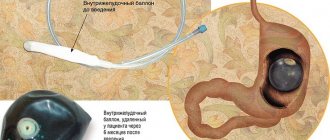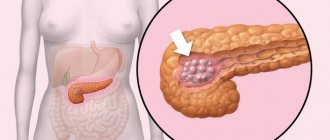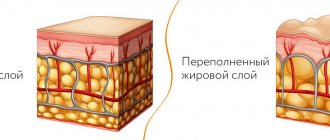A little history
The problem of obesity has existed for more than one millennium. For quite a long time in past centuries, a woman with curvaceous figures was represented as beauty, health and a symbol of fertility. They were immortalized on the beautiful canvases of many famous artists (Rembrandt, Van Dyck, Renoir, Kustodiev). Proponents of the time promoted accepting your body as it is. However, after a while, Hippocrates noted that the life of excessively obese people is short, and obese women, unfortunately, have a number of disorders in the reproductive sphere.
The disease is based on a disorder of fat metabolism, characterized by excessive development of adipose tissue, mainly in the subcutaneous layer and omentum, and due to this - excess body weight exceeding the limits of the physiological norm.
Obesity can be either an independent disease or one of the manifestations of another disease, most often associated with dysfunction of the endocrine glands or damage to the central nervous system.
Causes
Exogenous form.
The reasons for overeating can be different: feelings of loneliness, anxiety, melancholy and excitement. In this case, insulin resistance develops over time (when insulin in the blood plasma is increased).
Mechanism of action: with the intake of a large amount of food, glucose realizes its reserve in the cells of the liver and muscles, communication of insulin receptors is disrupted, some tissues and cells no longer respond to it, there is a lot of glucose and more cannot fit into the cell - insulin converts excess energy into fat .
Endogenous form (disorders of internal nervous, hormonal, enzymatic mechanisms regulating fat metabolism).
Insufficient physical activity is also of great importance, which may be due to occupation, diseases of the musculoskeletal system and other reasons. Ordinary nutrition can also lead to obesity if the functioning of the mechanisms regulating fat metabolism is disrupted.
Is it necessary to treat stage 2 obesity?
A healthy person does not develop excess weight, especially in such quantities as to be diagnosed with “2nd degree obesity.” The amount of fat deposits at this stage already reaches 30–49% of the total body weight and they contribute to the development of endocrine diseases and changes in metabolic processes. Common functional disorders in grade 2 exogenous constitutional obesity:
- hypertension;
- angina pectoris, ischemia;
- disorders of the intestines, stomach, liver;
- deterioration of immunity (frequent colds, ARVI);
- kidney dysfunction;
- skin diseases;
- respiratory failure;
- drop in libido;
- polycystic ovary syndrome in women, cancer of the uterus, mammary glands;
- infertility (in both sexes);
- increased risk of stroke, heart attack;
- development of problems with joints and the musculoskeletal system.
Clinical picture
Obesity develops more often in people over 40 years of age. Women are more susceptible to it than men. Excessive fat deposits predominate in the abdomen, chest, back, neck, hips and shoulders. Often, patients consult a doctor because of cosmetic defects caused by obesity. Patients complain of shortness of breath, pain in the heart area, interruptions, general weakness, fatigue, sweating, dizziness. Lethargy, drowsiness, and apathy are often observed. Obesity is usually accompanied by changes in the heart muscle and hemodynamic disturbances. Obese patients often have hypertension and early development of coronary and general atherosclerosis. A common complication of obesity, especially grade II and III, is circulatory failure (shortness of breath, cyanosis, edema), angina pectoris, and myocardial infarction. A high position of the diaphragm and a small excursion of the chest, as well as congestion in the pulmonary circulation contribute to the development of bronchitis and pneumonia. The liver is usually enlarged due to fatty infiltration and circulatory failure. Cholecystitis and cholangitis often develop with the formation of stones. Congestion in the kidneys is accompanied by albuminuria and microhematuria. Urolithiasis is often observed. One of the common complications of obesity is diabetes. Obesity usually develops slowly and tends to steadily progress if the necessary treatment and preventive measures are not carried out in a timely and systematic manner. One should keep in mind the possibility of developing severe obesity, characterized by enormous weight.
Types and forms of obesity
Abdominal type (apple)
- adipose tissue forms around internal organs.
Genoid type (pear)
- adipose tissue forms in the buttocks and thighs.
Exogenous (alimentary) form
in the initial stages it is characterized by uniform development of the subcutaneous fat layer throughout the body, but as the disease progresses, fat deposits predominate in the abdomen, pelvic girdle, chest, and cervical-occipital region. Patients are often characterized by a large appetite or gluttony (bulimia). There are no signs of endocrine insufficiency, but sometimes they are detected secondarily in advanced forms.
Endogenous forms of obesity.
Constitutional-hereditary obesity. It has much in common with nutritional obesity, but begins to manifest itself from an earlier age than the latter, is characterized by the presence of hereditary burden and is not necessarily associated with overeating.
Cerebral (diencephalic) obesity
associated with damage to the mechanisms of central regulation of fat metabolism. Develops as a consequence of damage to the interstitial brain due to birth trauma, brain contusion, complications after neuroinfection. It is characterized by a peculiar distribution of adipose tissue in the pelvic girdle, chest, and abdomen. Patients may experience bulimia, polydipsia and a number of other neurological symptoms.
Obesity with hypothyroidism
characterized by the proportional development of the subcutaneous fat layer, the presence of increased tissue hydrophilicity, pastiness, lethargy, drowsiness, dry skin, decreased basal metabolism and other manifestations of hypothyroidism.
Obesity in the disease and Itsenko-Cushing syndrome
characterized by disproportionate deposition of adipose tissue on the torso, neck, face with thin limbs. A number of other typical symptoms of the underlying disease make it easy to recognize this form of obesity.
Obesity with hyperinsulinism
characterized by uniform development of the subcutaneous fat layer throughout the body. It is caused by the need for frequent meals in large quantities caused by the disease. With a long-term disease, obesity reaches high levels.
The diagnosis for exogenous and constitutional-hereditary forms is made on the basis of excess body weight due to the development of adipose tissue and the exclusion of other diseases, one of the manifestations of which may be obesity. For the diagnosis of endogenous forms of obesity caused by diseases of the central nervous system and endocrine glands, data from a special neurological and endocrinological examination are important, as well as studies of the dynamics of metabolic processes (basic, water-salt, cholesterol, carbohydrate metabolism).
Characteristics of stage 2 obesity
Diagnosis is made by calculating BMI - body mass index, for which weight in kilograms is divided by height in square meters.
Obesity of the 2nd degree is observed in patients with a BMI of 35.0–39.9 units: excess weight is 15–17.5%. Additionally, the volume of the waist, chest, hips, and the thickness of the folds on the abdomen are assessed. The problem is also indicated by:
- shortness of breath with minimal physical exertion (a step slightly faster than a “walking” one);
- increased sweating (not associated with activity);
- increase in fat deposits in the waist area;
- increased heart rate;
- constant drowsiness, lethargy;
- swelling of the lower extremities and fingers.
Obesity 2 degrees in women
Fatigue, decreased physical activity and performance in women occur with a large amount of excess weight more often than in men. Increased emotional hunger (this can be seen, stress is created, which the woman tries to eat) - also due to psychological characteristics. In addition, the following symptoms appear:
- significant increases in the volume of the abdomen, hips, buttocks;
- fluctuations in blood pressure (frequent rises);
- waist circumference more than 80 cm;
- menstrual irregularities (the exogenous-constitutional form is not always accompanied even in grade 2);
- the appearance of stretch marks on the abdomen and thighs.
In men
In the absence of changes in hormonal balance, grade 2 obesity in men of the exogenous constitutional type is characterized by the appearance of fat deposits in the abdomen and chest area or their uniform distribution throughout the body. An increase in the volume of the hips and buttocks occurs due to disturbances in the production of testosterone and estrogen. The following may also indicate a problem:
- increased irritability;
- waist circumference more than 94 cm (more than 102 cm with a lack of testosterone);
- decreased potency.
Articles on the topic
- Causes of obesity in women - congenital, nutritional, psychological
- Causes of obesity in children of preschool and school age
- Exogenous-constitutional obesity of the 1st degree in men, women and children - diet
Prevention
Obesity requires active prevention and treatment. The main thing is a balanced diet, excluding overeating, mainly carbohydrates and fats. The daily calorie content of food is calculated based on the needs of a healthy person: for those engaged in work not associated with physical stress, no more than 40-50 kcal, for those engaged in heavy physical work - 50-60 kcal per 1 kg of weight. Daily caloric intake is calculated in accordance with the normal weight of a person, determined by the above formula. Systematic weighing is necessary to take into account the effectiveness of preventive measures, and in case of weight gain, additional dietary restriction. Physical activity and sports are of great importance in the prevention of obesity, recommended in an individual complex, taking into account age, the state of the cardiovascular system and other physiological indicators. Particular attention to the prevention of obesity should be paid in families with a hereditary predisposition to it and in those with diseases of the nervous system and endocrine glands, accompanied by dysregulation of fat metabolism.
Causes of obesity:
Exogenous factors:
- increasing portion sizes, regular overeating;
- high-calorie diet, the presence in the menu of a large amount of food rich in simple carbohydrates and fats: baked goods, sweets, pasta, fatty meat dishes;
- disrupted daily rhythm of food intake, eating disorders, incorrect eating habits: lack of diet, eating high-calorie and heavy foods at night;
- learned types of nutrition (we are talking about national traditions);
- sedentary lifestyle;
- chronic stress.
Endogenous factors:
- diseases associated with metabolism: diabetes mellitus, hypothyroidism, diseases of the adrenal glands and pituitary gland (Itsenko-Cushing's Syndrome and Disease, prolactinoma, somatotropinoma).
- hormonal imbalance due to excessive or insufficient functions of the gonads (PCOS, hyperandrogenism).
Most often, women are at risk during pregnancy and lactation or during menopause. These age groups are considered the most critical. In 75% of cases, obesity of alimentary-constitutional origin is diagnosed in women.
In medicine, nutritional obesity is a disease associated with impaired metabolism. Along the way, pathologies can also be helped to develop by other harmful factors, most often external (lack of physical activity, for example), less often internal (diseases of organs and systems). Heredity and disorders of the brain and psyche are excluded from the causes. Everything else can contribute to the progression of the disease in one way or another.
It turns out that nutritional obesity is the fault of the person himself, who cannot organize and balance his own diet. If the body takes in more calories than it expends, this will invariably lead to excess body weight. And you can’t blame heredity and congenital neuropsychiatric diseases here.
However, there is one big advantage in this: if a person himself has brought his body to such a state, then he can also get rid of it himself by pulling himself together and going through the entire course of treatment from beginning to end under the supervision of specialists.
Treatment
Patients with obesity should be explained that it depends on the increased calorie content of food and that only long-term treatment, with a low-calorie diet, can help. The doctor will draw up a nutrition plan that includes fiber, vitamins, active substances and reducing the consumption of carbohydrates and fats. With mild obesity, the daily calorie content is limited to 2000 kcal; with moderate obesity, the calorie content is reduced to 1400-1500 kcal. When treated in a hospital or sanatorium, a diet with a large calorie restriction of up to 1000-1200 kcal can be used. A medicinal method using tablets and injections is possible. Surgical treatments are available to treat extreme obesity.
Physiotherapy is indicated for all degrees of obesity. Its choice requires an individual approach, taking into account the state of the cardiovascular system mainly. Recommended physical therapy, walking, skiing, skating, rowing, swimming, outdoor games, sports exercises after appropriate training, water procedures: wiping the body with a towel soaked in cool water, followed by rubbing with a dry towel, dousing with water at room temperature, regular baths , mineral, carbon dioxide, showers (rain, circular, fan, Charcot shower, Scottish).
Collaboration between the doctor and the patient is very important for getting rid of extra pounds, without harm to the body. Our qualified doctors at the clinic will identify not only the causes of obesity, but also adjust a balanced diet. In addition, we carry out a number of all necessary physical procedures aimed at correcting your figure. We are proficient in European methods in the treatment of obesity with existing chronic diseases.
You need to keep your body strong to keep your spirit strong.
Victor Hugo
You can get a doctor’s consultation at our endocrinology center in Samara by sending an online application from the website or by calling. Be healthy!











